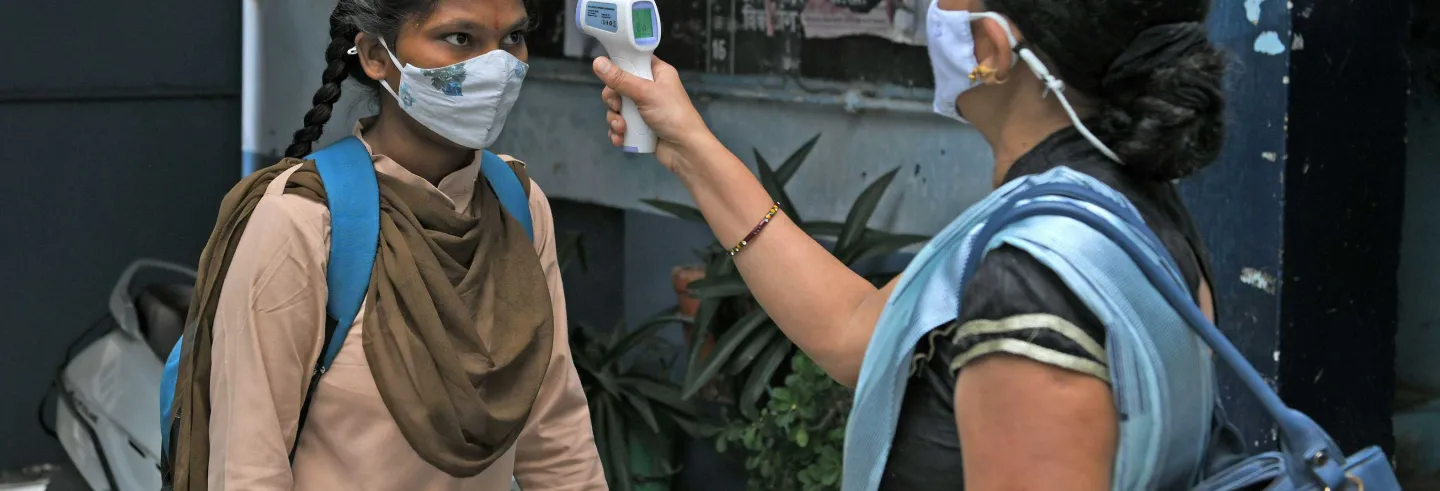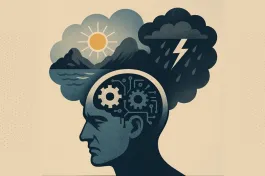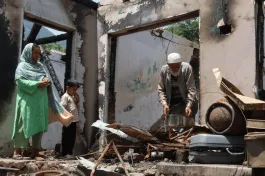For most infections affecting humans, the young and old are most at risk while adults enjoy relatively more protection. If this age distribution is plotted on a graph, it appears in the shape of a ‘U’. The age distribution for severe disease and mortality due to Covid-19 is different since the infection causes only mild illness in all children.
The plotting of Covid-19 infection according to the age of the infected gives a ‘J’ shaped curve, with a 10-year-old being at the base of the J and at the lowest risk. The short arm of the J represents infections in the age group of 0–9 years and the long arm of children 11 years and older. From the base of the Covid-19 curve, the risk of severe disease increases in both directions. However, all children — in the 0–17 years age group —are at very low risk in comparison with adults.
Eighteen months into the pandemic, scientists, immunologists, and medical researchers have gained insights into why children have greater protection from Covid-19. One, children have a higher level of active neutrophils in the epithelial cells of the nose, which start eating the viral particles before they have a chance to replicate. Two, to develop into a severe disease, Severe Acute Respiratory Syndrome Corona Virus-2 (SARS-CoV-2) — the virus that causes Covid-19 — needs to enter the lungs of an affected person and multiply. For that, it needs to attach itself to the ACE-2 receptors in the lungs of the person. These receptors are underdeveloped in the children. Three, children have a very high expression of a gene encoding MDA5 receptor, which recognises viruses quickly and triggers production of interferons. While in adults this response takes two days to get activated, in children it starts on day zero. Four, soon after an infection, children start producing high levels of signalling proteins, such as interferon-gamma and interleukin-17 (a process mediated by the innate immune system), which very quickly alert and activate the immune system. In adults, the primary mode of response is through the far slower mechanism of antibody formation by adaptive immune response.
Eighteen months into the pandemic, scientists, immunologists and medical researchers have gained insights into why children have greater protection from Covid-19.
These facts, combined with the epidemiological evidence, have led to a consensus amongst health experts that while children do get SARS-CoV-2 infection at a rate nearly similar to the adults, they do not develop severe disease and the risk of death is extremely low.
The statistics that are available show that in the United States, to cite an example, as of end September 2021, across 45 states between 0% and 0.03% of Covid-19 cases in children resulted in deaths. Of all Covid-19 deaths recorded these states, between 0% and 0.26% were in children, with seven states not reporting any child death due to Covid-19. In the same report, the American Paediatric Society noted that “At this time, it appears that severe illness due to COVID-19 is uncommon among children.”
At the beginning of the pandemic, schools were closed in most countries on the assumption that SARS-CoV-2 would behave similarly to other pathogens. However, in the months that followed, with a better understanding of Covid-19, most countries started to reopen schools and a few never closed them even at the peak of the pandemic. Informed by the global evidence, UNESCO and UNICEF, in a joint statement in July 2021, stated that in pandemic-related restrictions, schools should be the last to close and the first to reopen (after health facilities). Encouraged by the evidence, by mid-July, nearly 16 months after the start of the pandemic, more than 170 countries had reopened the schools to varying extents.
School reopening in India
Until mid-July, schools were not open for in-person classes in any state or union territory of India. In fact, India has the dubious distinction of being in the top five countries across the world where schools have been closed for the longest duration. On 20 July, when preliminary findings from a fourth nationwide sero-survey in India were announced, it was revealed that an estimated two-thirds of India’s population had developed antibodies, either after natural infection (mostly) or through Covid-19 vaccination. The survey noted that children had developed antibodies (thus exposed to SARS-CoV-2) at a rate similar to the adults. By then, most Indian states (other than Maharashtra, Kerala and a few southern and north-eastern Indian states) were reporting far fewer new infections of Covid-19.
[T]here is no data from any part of the world that the third or any subsequent wave of the Covid-19 pandemic does or will disproportionately affect the children.
It was the right time to open schools. The Indian Council of Medical Research suggested that the primary schools should be the first to open. Yet, state governments in India were reluctant to take a decision. In fact, soon after the release of the scientific findings of the sero-survey, the dominant discourse became that (a) the third wave would affect children and thus let us not open schools and (b) let us wait for vaccinations of children to be completed before reopening schools. Both these statements are not evidence-based.
The discourse that ‘the third wave would affect children’, arguably the most damaging misinformation spread during the Covid-19 pandemic in India, got a boost with an article in mainstream media and from the remarks by a well-known doctor, even though the assertion had no backing of data or scientific evidence. It had so much shock value and emotional connect that it made headlines in nearly every newspaper and became the subject of prime-time debates. In a trademark slow government response, it was officially refuted only many weeks later. By then, it had become gospel truth for most people. The fact was and is that there is no data from any part of the world that the third or any subsequent wave of the Covid-19 pandemic does or will disproportionately affect children.
Then, in the midst of 'the-third-wave-would-affect-children’ narrative, the government announced a strengthening of paediatric beds and ICUs in every district of India, with the argument that we should be prepared for the worst. This fuelled the fire of misinformation rather than dousing it. After what citizens experienced in the second wave of Covid-19 in India, where people had to fend for themselves for hospital beds and oxygen, the trust and faith in the government’s words and ability to handle the pandemic was severely eroded. Against this backdrop, suspicious of anything being said, people started making assumptions about why, if children were not at risk, the government was strengthening paediatric care facilities. The suspicion was that something was being hidden. This lack of trust resulted in further spread of misinformation.
The global evidence is unequivocal that Covid-19 vaccination is not a prerequisite for opening schools.
The government repeated the same mistake in the discourse on Covid-19 vaccination of children. In an equivalent of ‘the third wave would affect children’, in August another discourse supported by well-known doctors became popular, arguing ‘let's vaccinate children before opening schools’.
The global evidence is unequivocal that Covid-19 vaccination is not a prerequisite for opening schools. Yet, rather than categorically refuting misinformation, in media interactions and briefings, government officials started providing tentative dates of when the Covid-19 vaccination of children in India would start. This inadvertently reinforced the belief of parents that children need to be vaccinated before they could attend school.
Children and Covid-19 vaccination
A few countries have started vaccinating 12- to 17-year-old children. However, most countries have not started doing so. Schools are now open in both groups of countries.
The availability of an approved vaccine is not the only consideration before deciding on the vaccination of any age group. The disease burden and the risk and benefits of vaccination in that age group are bigger considerations. The currently licensed Covid-19 vaccines prevent moderate to severe illness and death. The burden of these conditions is very low on children. Therefore, the benefit of Covid-19 vaccination in children is low.
The currently licensed vaccines are safe. However, a few rare adverse events have been reported. The younger the person, the higher the risk of rare Covid-19 vaccine-related adverse events such as viral myocarditis (after mRNA vaccines) and blood clotting or thrombosis with thrombocytopenia syndrome (TTS) after viral-vectored vaccines.
There is emerging epidemiological data that points out that the risk of hospitalisation among unvaccinated children is far lower than risk of hospitalisation among fully vaccinated adults. Clearly, the priority has to be achieving a higher coverage of vaccination in adults. A preprint paper published in September 2021, estimated that the boys in the age group of 12 to 17 years have a higher probability of hospitalisation due to adverse events after Covid-19 vaccination than the probability of hospitalisation due to Covid-19 infection. In children, the benefit of vaccination is relatively low, and risk is comparatively higher. Therefore, many countries have decided to vaccinate only those 12- to 17-year-olds who have pre-existing illnesses.
[T]he benefit of Covid-19 vaccination in children is low.
This is not to conclude that none of the children need Covid-19 vaccines. A few currently licensed and available vaccines are recommended for identified high risk and vulnerable children (such as those who are immunocompromised, have pre-existing illness, or are on long term treatment) in the 12 to 17 age group. In addition, the benefit of vaccinating children would be to reduce transmission, but there is limited evidence on how far the currently licensed and used Covid-19 vaccines in India reduce transmission. That therefore cannot be the objective of vaccinating children, at least not at present.
Once one or more vaccines with a proven role in reducing disease transmission, like nasal vaccines, become available, the situation might change. That could be enough justification to offer vaccines to a wider group of children.
In epidemiology, the context matters
During much of July–September 2021, media reports from the US and UK on rising Covid-19 cases in all age groups, including children, were extensively referred to and quoted in India in making the argument against reopening schools. Ironically, in the US and UK schools continue to be open.
The spread of an infection or disease in a community or a country is determined by a complex interplay of the agent, the host, and the environment, together termed as the ‘epidemiologic triangle or triad’. This is an age-old concept in epidemiology. This triad explains why the situation in India is not necessarily similar to the situation in the US, the UK or any other high-income country.
In the Covid-19 pandemic, SARS-CoV-2 is the agent in all settings. Every human being is a host for SARS-CoV-2. However, the behaviour of the host (whether the hosts adhere to Covid-19 appropriate behaviour) and her individual characteristics (age and co-morbidities) determine the probability of infection as well as the disease outcome. The host factors are slightly different in those settings. In many US and UK settings, a larger proportion of people do not practice to mask wearing and other Covid-19 appropriate behaviours. The average age of the population and the proportion with co-morbidities is also far higher in those countries, placing them at a higher risk of poor outcome. Finally, according to various surveys, children in India have already been exposed to the virus and 60% to 80% have developed antibodies.
The spread of an infection or disease in a community or a country is determined by a complex interplay of the agent, the host, and the environment.
The most important difference between India and the US and UK in this triad is the external or environmental factor. The US and UK are witnessing a fresh wave due to the spread of the Delta variant, which was responsible for the second wave in India. Virology and science tell us that the same variant is unlikely to cause a fresh wave in quick succession in any setting. This, when supplemented with other evidence that schools do not result in an increased community transmissionand that they are not ‘super-spreading’ places, can make us conclude that with appropriate mitigation measures, schools can be reopened in periods of low transmission.
Disconnect from the ground and inequities
The discourse in India on reopening schools in India has, once again, revealed the largely urban and elitist dominance and a disconnect from grassroots evidence in policymaking. The schooling of children in rural and as well as of the urban poor was missing in the discourse. Many surveys found that online education was not an option for most of these children. A survey of nearly 1400 students in 15 states of India in July 2021 found that the education of a majority of poor children in both rural and urban settings was nearly halted during the pandemic and that 60% to 90% of the parents of children studying in government schools wanted in-person classes.
The failure to provide equitable learning opportunities to our children in Covid-19 times is an indictment of our society.
Yet, television and newspapers are influenced by the opinions and views of a very small fraction of the rich, urban, articulate, English-speaking parents, whose children have had access to every possible learning resource including personalised tutoring. In the process, the children of the poor (and also often voiceless) suffered and educational inequities widened. The sustained closure of Indian schools arguably violates the rights of children.
Safely reopening of schools is possible
Starting in early August, when a slow and reluctant reopening of schools in a few Indian states began to take place, newspapers and television channels began reporting a rising number of Covid-19 cases among children. These news reports were correct but the interpretations were wrong. The fact was that after schools reopened, states started proactive testing for Covid-19 in children, which resulted in higher detection of cases. There was no increased transmission.
It is not that school opening is completely free of risk. Modelling studies and analyses show that when children return to school, it may result in no increase or some increase in the number of cases in various settings. Two key risks are: (a) children bringing the infection back home to high-risk unvaccinated members of the family and (b) some vulnerable children themselves developing a severe disease after getting the infection. Both these risks are real and can and should be minimised. Adult members in the family should be encouraged to get fully vaccinated. The vulnerable or high-risk children (with pre-existing health conditions which require sustained treatment or those with known immunodeficiency disorders) should avoid attending in-person school till other options such as vaccines for such children are available.
In India, there is no official data available on what proportion of children can be grouped as high risk. This proportion is estimated to be around 2%. With vaccination coverage going up and the coverage of the fully vaccinated in high-risk population groups being the highest, an estimated 90% to 95% of school going children can now attend in-person classes, without any additional risk to them or members of their family . The children in the primary school age group — 6 to 14 years — are at the lowest risk of Covid-19 (the J-shaped curve). Their loss in terms of learning is the highest. That is why primary schools should be the first to open.
Schools can be safely opened by taking certain precautions: (a) vaccination of school staff and members of the child’s family; (b) improved ventilation of classrooms including keeping doors and windows open, installing exhaust fans as and where possible, and holding some classes in outdoor or open spaces, and (c) adherence to wearing masks. What we need to remember is that most children in India are already protected from moderate to severe disease and each of these precautions are supplementary measures of protection.
Medically speaking, everything that is mandated for adults is not fully applicable to all children. For example, masks in public places are mandatory for all adults. However, mask recommendations are different for children. According to Government of India guidelines, masks are not recommended for children up to 5. Children in the 5 to 12 age group may wear masks as much as possible. For children older than 12, masks are mandatory just as for adults. Maintaining a physical distance between individuals is important but the norms here follow the same approach as for wearing masks. The Indian government recommends 6 feet (1.8 metre) of physical distancing, but that is an abundant pre-caution and the World Health Organization (WHO) recommends at least 1 metre distance.
The scientific evidence is that the risk of reopening schools is very low and the benefits of resumption of in-person schooling are very high.
The emerging evidence is that there are low chances of catching a Covid-19 infection by touching objects (the so-called fomite transmission). Therefore, handwashing should be encouraged but we should not panic about children not washing their hands after getting off the school bus or after touching books of a schoolmate or any surface. Also, there is limited scientific evidence on the benefits of regular monitoring of temperature or screening of symptoms in schools.
The majority of parents in India want schools to be open. However, a small proportion of parents who opposed school reopening appears to be swayed by newspaper headlines. The decision to open schools requires a calm assessment of all the pieces of scientific evidence that need to be examined in their entirety. The scientific evidence is that the risk of reopening schools is very low and the benefits of resumption of in-person schooling are very high. Governments should make decisions from the societal perspective of what is good for the majority of the children. Most schools, including government schools, can be reopened safely with the minimal amount of additional preparation.
What are the learnings?
There are a few lessons we can learn from this experience of having schools closed since March 2020.
First, it will not be an exaggeration to say that India’s children have suffered as the government either had no data or did not use data on Covid-19 that they did have to inform decision-making. This is another reminder of the urgent need to strengthen the health data recording and reporting system in India. Second, India’s policymakers and health experts can do far better by improving science communication and refuting misinformation. Third, we cannot be unscientific and populist one day (banging utensils, clapping hands, and recommending unproven therapies) and rational, evidence-based and scientific the next. Policymakers need to show consistency and use science and evidence for decision-making. Fourth, there is a need for institutionalising a three-way partnership between (a) political leaders and policymakers, (b) technical experts on medicine and public health, and (c) members of the community to facilitate coordinated people-centric decision making. Fifth, and most important, schools in all Indian states can now be safely reopened in a decentralised (local level decision-making at the level of schools, villages, blocks and district) and phased manner by taking required preventive measures. Sixth, school reopening should not be contingent upon the Covid-19 vaccination of children. Seventh, reopening should not be considered the end of it all. Governments have to plan for developing strategies and mechanisms for compensating for the learning losses.
School closure and the loss of learning reflects the social impact of a disease. The outcome of continuous closure of schools in India is that children are turning out to be the population subgroup affected the most during the Covid-19 pandemic, in spite of them being the least at risk of severe disease. It is not whether schools should be open or not. It is how and what needs to be done to ensure the return of every child to the school, at the earliest.
The India Forum welcomes your comments on this article for the Forum/Letters section.
Write to editor@theindiaforum.in










